Are you a bird enthusiast and want to go on an adventure of spotting birds with long beaks? We’re here to help! We’ll tell you about 14 species – how they look, how long their beaks are, and where you can spot them! Read on to discover more!
14 Birds with Long Beaks
Some birds have incredibly long beaks! Undoubtedly, they provide their “owners” a remarkable appearance and attract bird enthusiasts from around the world to watch them in their natural habitats.
However, this isn’t the only role and definitely the least important role long beaks play. First and foremost, birds use their long beaks to survive, as they’re of great help in gathering food, as well as tearing or crushing food.
Some birds may simply die from starvation if not for their beaks! Many birds use their bills to look for food through the mud. Others, like hummingbirds, use their bills to catch insects and drink sugar water.
Moreover, some species perform skimming acts – while flying low, these birds drag their lower mandible through water, thus catching fish or other foods.
Keep reading to learn more about 14 birds with long beaks!
1. Great Spotted Kiwi
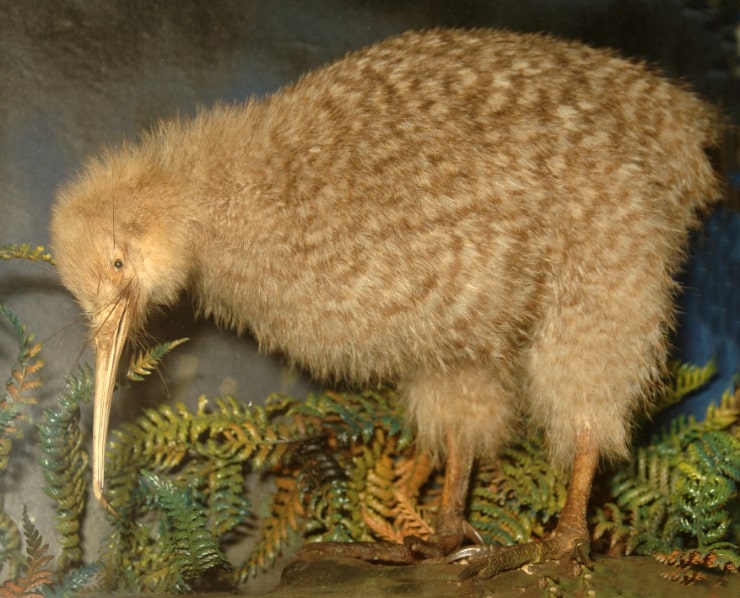
- Scientific name: Apteryx haasti
- Size: 18 – 20 inches tall
- Weight: 2.6 – 7.3 pounds
- Beak Length: 3.5 – 4.7 inches
Great spotted kiwis have pear-shaped bodies, small heads and necks, and long bills. Their plumage is usually gray but can have different shades, including light brown.
These birds are endemic to New Zealand. More precisely, they live on the South Island, where they are restricted to three localities only as a consequence of invasive species predation. They typically prefer inhabiting higher altitude environments ranging from 2,300 to 3,600 feet.
These long-beaked birds are monogamous, forming pairs lasting as long as twenty years! Their breeding season lasts almost a year – it starts in June and lasts until March. During this time, they build their nests in burrows and usually mate 2 – 3 times.
As you’ve probably already guessed, these birds aren’t migratory. But there’s more to this! Did you know that great spotted kiwis cannot fly? Besides this, if we were to compare them to other birds, these ratites (flightless birds) have a much lower body temperature!
2. Dalmatian Pelican
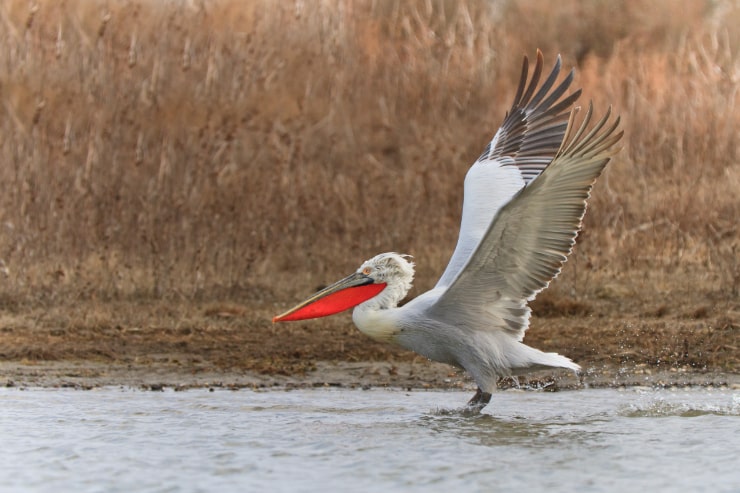
- Scientific name: Pelecanus crispus
- Size: 5.25 – 6 feet
- Weight: 16 – 33.1 pounds
- Beak Length: 14 – 18 inches
You’re probably already familiarized with the pelican family. What you possibly don’t know is that the Dalmatian pelican is the largest family member! Its plumage is silvery-white (during the non-breeding season), the legs are gray, and it exhibits curly nape feathers.
These large pelicans are endemic to Eurasia, where they live in rivers, lakes, estuaries, and deltas. Since Dalmatian pelicans are widely distributed across Eurasia, their migration routes highly vary depending on where they breed. They’re usually short-distance migrants, and their migration patterns often change.
Here’s another interesting fact about this species – besides being the largest in the family, it’s also the least social! During the breeding season, Dalmatian pelicans nest either alone or in small groups. Their nests are typically built on dense floating vegetation.
3. Sword-Billed Hummingbird
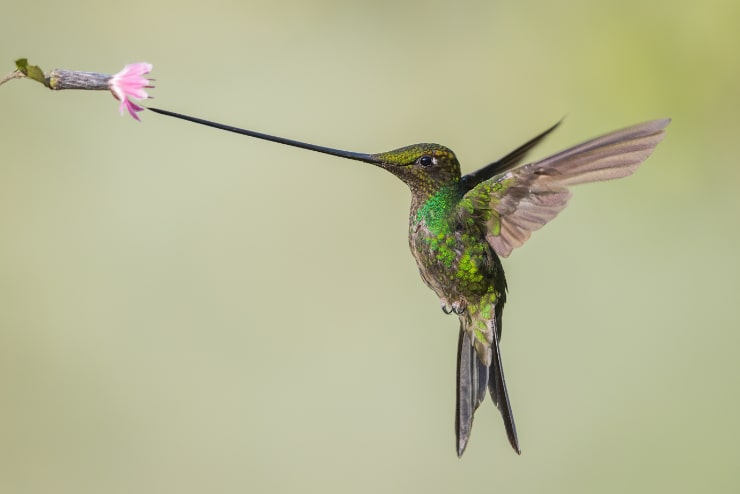
- Scientific name: Ensifera ensifers
- Size: 5.1 – 5.5 inches
- Weight: 0.35 – 0.53 ounces
- Beak Length: 3.1 – 4.7 inches
The sword-billed hummingbird is undoubtedly a unique bird! Besides having an extraordinarily long beak, it also has a distinctive plumage with shades of green, bronze, and gray.
Unfortunately, these birds are endemic to a small part of South America. Sword-billed hummingbirds are found in the Andes Mountains on the western part of the continent. People living in the area may even get lucky enough to have some of these hummingbirds visit their gardens!
Although these birds do not migrate, they do move between regions in their natural habitats. For example, they move to higher altitudes in the early wet season and prefer remaining at lower altitudes during the dry season.
Sword-billed hummingbirds breed from February to March, building their hanging cup-shaped nests among root fibers.
4. Red-Necked Avocet
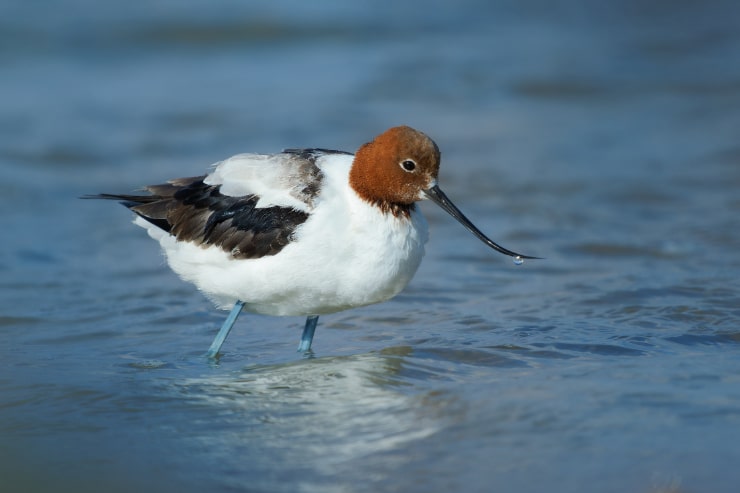
- Scientific name: Recurvirostra novaehollandiae
- Size: 17 – 17.5 inches
- Weight: 10.9 ounces
- Beak Length: 3.2 – 3.7 inches
Red-necked avocets are often called Australian avocets, cobbler’s awls, and painted ladies. These waders have a noticeable upcurved bill they use for catching small invertebrates from the water surface. Their chestnut brown heads and necks can help you distinguish them from other birds.
Your only chance of observing a red-necked avocet is traveling to Australia since the species is endemic to the continent. However, you’ll still have to have luck on your side, as the birds are highly nomadic. On the other hand, they prefer salt or brackish water, meaning they often settle in shallow wetland areas or estuarine mudflats.
The breeding season usually occurs between August and November, although this highly depends on the weather. Male birds perform distinctive courtship dances, and after mating, the pair has specific postures intended to defend the nesting grounds.
We’ve got a fun fact for you, too! In 1966, the red-necked avocet appeared on a 13-cent postage stamp – how awesome is that?!
5. Far Eastern Curlew
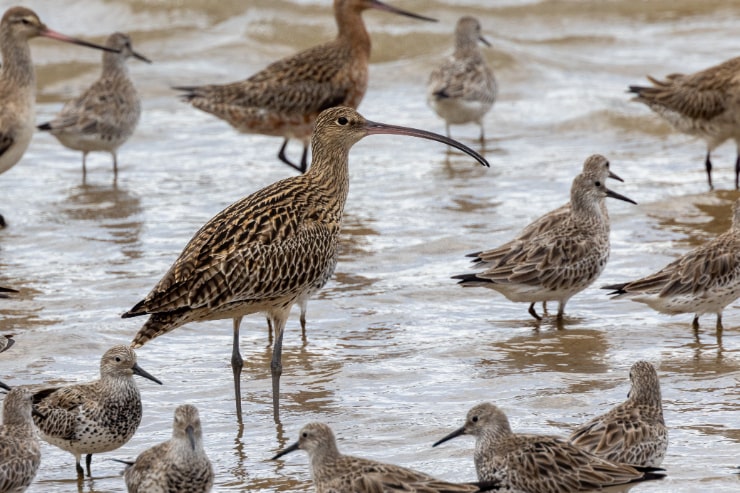
- Scientific name: Numenius madagascariensis
- Size: 24 – 26 inches
- Weight: 1.2 – 2.5 pounds
- Beak Length: 5 – 7.9 inches
The Far Eastern curlew is yet another bird on our list with an interesting appearance. Besides its very long, distinctive beak, the bird’s plumage features different shades of brown. Moreover, the bird is often called the world’s largest sandpiper species!
Far Eastern curlews are migratory birds. They’re found in northeastern Asia in marshy and swampy lakeshores during the breeding season. Most Far Eastern curlews fly to coastal Australia when the temperatures start dropping. Others overwinter in Thailand, South Korea, or New Zealand. Unfortunately, the species is listed as Endangered, so now’s your chance to observe it in the wild and maybe even contribute to conservation efforts.
Another interesting fact about this species is that its decurved beak is extremely useful for catching invertebrates in the mud.
6. Pied Avocet

- Scientific name: Recurvirostra avosetta
- Size: 16.5 – 17.7 inches
- Weight: 8 – 14 ounces
- Beak Length: 2.9 – 3.3 inches
The pied avocet has a distinctive plumage featuring a white-and-black combination. Their long bills are upturned, while the long legs have a remarkable bluish color.
These waders are migratory. During the breeding season, they’re found in temperate Europe, as well as across the Palearctic. At this time, they inhabit shallow lakes that feature exposed bare mud.
Some spend their winters in warmer regions within their range (southern Europe, for example), while others prefer flying to southern Asia and Africa.
Did you know that avocets, pied avocets included, have a feeding technique specific only to their genus? They use their bills to catch food in shallow brackish water and scythe them from side to side, thus facilitating foraging.
7. Roseate Spoonbill
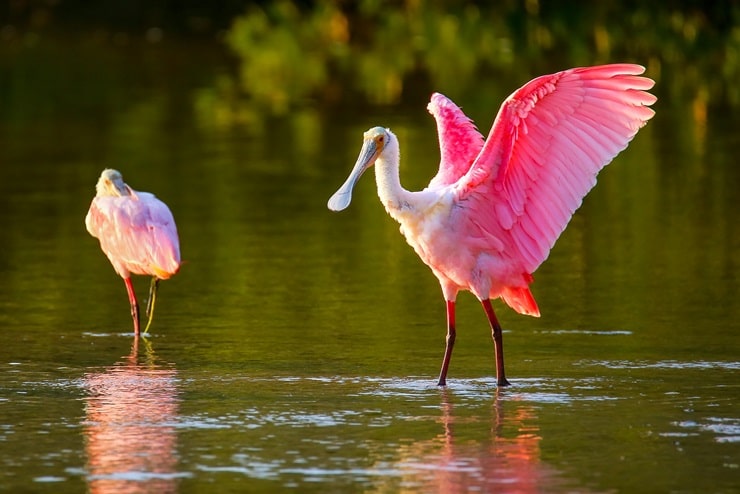
- Scientific name: Platalea ajaja
- Size: 28 – 34 inches
- Weight: 2.6 – 4 pounds
- Beak length: 4 – 6 inches
At first, roseate spoonbills may look like flamingoes, thanks to their beautiful, bright pink color. However, you can distinguish the two by the former’s greenish heads and white necks, breasts, and backs.
Spotting them shouldn’t be an issue as long as you visit their natural range – in the United States, they are common in Florida, Texas, and southwestern Louisiana; it is a common species in the Caribbean Islands, Central and South America, Mexico, and the U.S. Gulf Coast. Although their population almost went extinct in the past, they’re now listed as Least Concern, and their numbers are constantly increasing.
Look for these pink, long-legged birds near shallow fresh or coastal waters, as these are their preferred feeding grounds. During the breeding season, you might spot roseate spoonbill nests in trees, shrubs, or mangroves.
8. Red-Billed Scythebill

- Scientific name: Campylorhamphus trochilirostris
- Size: 9.5 – 11 inches
- Weight: 1.2 – 1.9 ounces
The red-billed scythebill is a woodcreeper having a red-brown back and a cinnamon belly, while the head is distinctively covered in brown-white streaks. The bird has a long, curved bill that distinguishes it from other birds with a similar appearance. The long beak helps it pick invertebrates out of tree trunks and branches.
Although little is known about this species, it is, in fact, among the most widely distributed in the genus. If you want to observe a red-billed scythebill, you can travel to Argentina, Brazil, Bolivia, Colombia, or Ecuador and look for it in tropical and subtropical dry forests, as well as in moist montane and lowland forests.
The species’ breeding season is typically associated with seasonal rains, although it may depend on where the birds are located geographically. Their nests are built in natural cavities, usually up to 16 feet above the ground.
9. Common Snipe

- Scientific name: Gallinago gallinago
- Size: 9.8 – 10.6 inches
- Weight: 2.8 – 4.9 ounces
- Beak Length: 2.2 – 2.8 inches
The common snipe is a beautiful bird with mottled brown plumage covered in yellow stripes on the upper parts. The beak is straight and of a darker shade.
These waders are endemic to the Old World (Eurasia and Africa). Common snipes breed in the bogs and marshes found in the Palearctic. When temperatures drop, they migrate to warmer areas, often to southern and western Europe, Africa, and southern Asia.
During the breeding season, male birds have a curious courtship display, performing high circles while flying and then taking shallow dives. This makes their tail feathers vibrate and produce a distinctive sound. The nests of common snipes are typically built on the ground in hidden locations.
Also Read: Birds with Long Necks
10. Jabiru

- Scientific name: Jabiru mycteria
- Size: 47 – 55 inches
- Weight: 9.5 – 19.8 pounds
- Beak length: 9.8 – 13.8 inches
The jabiru is a stork bird in the Ciconiidae family. It’s one of the birds exhibiting a strong sexual dimorphism in terms of size – females are around 25% smaller than males. However, they are similar in terms of plumage color – both are primarily white.
These birds are common in Central and South America, although some were also spotted in the United States. Since jabirus feed on aquatic or semi-aquatic species, they prefer inhabiting wetlands. Therefore, they’re most often spotted near ponds or rivers. These wading birds are generally non-migratory but may sometimes change their feeding grounds.
Jabirus are solitary birds believed to form lifelong bonds with their partners. During the breeding season, these storks build large nests they often use for several seasons. Both male and female birds participate in incubating the eggs and then take care of their young for around six months before they leave. This is why the pairs often cannot breed in successive seasons. However, since jabirus have a lifespan of 36 years, there’s more than enough time for them to maintain their population steady!
11. Yellow-Billed Stork
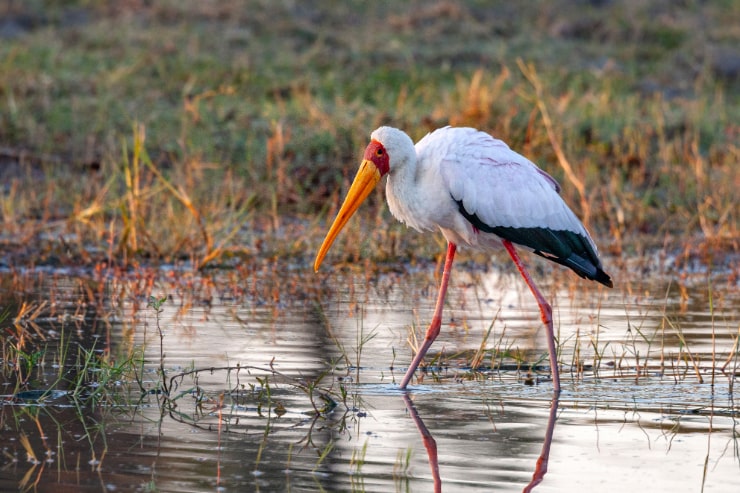
- Scientific name: Mycteria ibis
- Size: 35 – 41 inches tall
- Weight: 4.2 – 5.1 pounds
- Beak Length: 7 – 8.8 inches
The yellow-billed stork is often called a wood ibis. It has a black tail, a deep yellow bill, and a distinctive unfeathered red head.
These birds are most common in Eastern Africa. However, some reached other parts of the continent, including South Africa and even Madagascar. Yellow-billed storks aren’t considered migratory but may move within their range during rainy seasons. For example, the birds in Sudan fly from the north to the south, while others can perform longer flights to and from South Africa. Natural habitats of yellow-billed storks include mudflats, wetlands, and shallow lakes.
Although not considered generally migratory, these birds are known to prefer breeding in Kenya and Tanzania, even though other breeding grounds have been recorded, too. This usually happens during the peak of long heavy rainfalls since it is linked with more food sources.
Also Read: Birds with Long Legs
12. Hudsonian Whimbrel

- Scientific name: Numenius hudsonicus
- Size: 15 – 19 inches
- Weight: 9.5 – 17.4 ounces
- Beak Length: 4 – 5 inches
Since they’re part of the same genus, the Hudsonian whimbrel resembles the Far Eastern curlew. It has grayish-brown plumage with a distinctive pattern of white spots and a curved bill that’s longer in adult female birds.
Since they’re migratory birds, Hudsonian whimbrels spend their breeding season in subarctic North America and fly to southern North America and South America to reach their wintering grounds. You can also check North American coastal areas during migration if you’re a bird-watcher and want to observe a Hudsonian whimbrel.
During the breeding season, Hudsonian whimbrels are found in tundra, while wintering grounds include beaches, mudflats, and salt marshes.
13. Great Hornbill
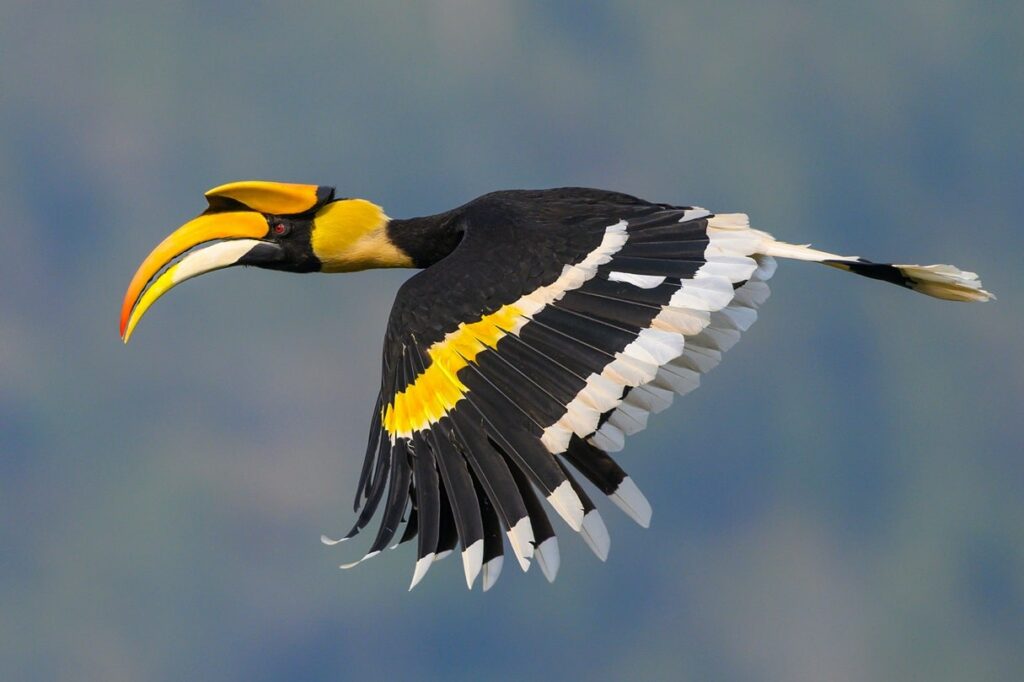
- Scientific name: Buceros bicornis
- Size: 37 – 51 inches
- Weight: 4.4 – 8.8 pounds
- Beak Length: 9 – 10 inches
One of the most distinctive birds on our list is the great hornbill, also called the concave-casqued hornbill or the great Indian hornbill. It’s among the largest hornbill species and has a bright yellow bill and a black casque on top of it. The plumage is a combination between black, white, and yellow.
You can spot a great hornbill if you travel to Asia – more precisely, to India, Nepal, Bhutan, Sumatra, and mainland Southeast Asia.
Look for this bird in dense forests at higher altitudes. A study shows that an important home for the great hornbill is the Nameri National Park and the Eastern Himalayan Mega Biodiversity Hotspot implicitly.
The birds in the area are known to be migratory. During the breeding season, meaning sometimes between January and April, great hornbills travel to the lower forest, where they build nests in tree cavities. Afterward, they fly back to the high forest.
Because of habitat loss caused by deforestation, as well as hunting for meat, fat, casque, and tail feathers, great hornbills are now listed as Vulnerable. Nowadays, some are held in captivity, but successful breeding is rare because they are very selective in choosing their mate and usually form strong pair bonds.
Also Read: Birds with Long Tails
14. Black Skimmer
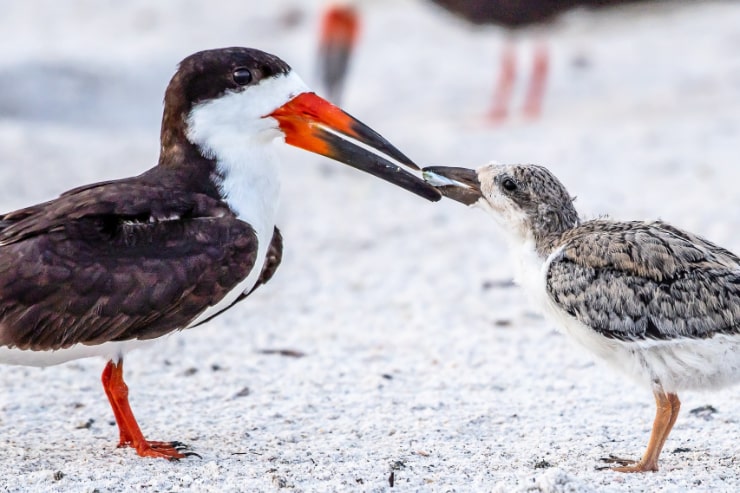
- Scientific name: Rynchops niger
- Size: 16 – 20 inches
- Weight: 7.5 – 15.8 ounces
Black skimmers are the largest among the three species in their genus. They have black-and-red bills, red legs, and black-and-white plumage.
They are considered a migratory species, although not all populations migrate. Only northern populations travel to warmer areas, typically to the Caribbean or the subtropical and tropical Pacific coasts. The birds living in South America move to different regions only after annual floods.
During the breeding season, black skimmers build their nests on sandy beaches or sandbanks and lay 3 to 7 bluish eggs. Both male and female birds participate in incubation.
These birds use their long beaks to feed in mid-flight. They fly close to the water’s surface, and drop their lower mandible in the water, thus skimming it for fish, insects, or crustaceans.
